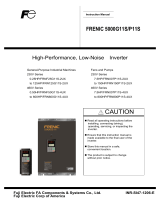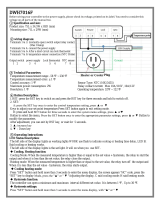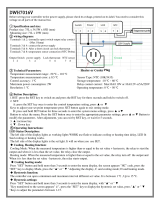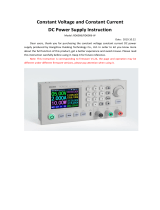Page is loading ...

MEHT536a

High Performance, Multifunction Inverter
User's Manual

Copyright © 2010 Fuji Electric Corp. of America
All rights reserved.
No part of this publication may be reproduced or copied without prior written permission from Fuji Electric Corp.
of America.
All products and company names mentioned in this manual are trademarks or registered trademarks of their
respective holders.
The information contained herein is subject to change without prior notice for improvement.

i
Preface
This manual provides all the information on the FRENIC-MEGA series of inverters including its operating
procedure, operation modes, and selection of peripheral equipment. Carefully read this manual for proper use.
Incorrect handling of the inverter may prevent the inverter and/or related equipment from operating correctly,
shorten their lives, or cause problems.
The table below lists the other materials related to the use of the FRENIC-MEGA. Read them in conjunction with
this manual as necessary.
Name Material No. Description
Catalog MEH535 Product scope, features, specifications, external
drawings, and options of the product
Instruction Manual INR-SI47-1457-E
Acceptance inspection, mounting & wiring of the
inverter, operation using the keypad, running the motor
for a test, troubleshooting, and maintenance and
inspection
RS-485
Communication
User's Manual MEH448
Overview of functions implemented by using
FRENIC-MEGA RS-485 communications facility, its
communications specifications, Modbus RTU/Fuji
general-purpose inverter protocol and functions, and
related data formats
The materials are subject to change without notice. Be sure to obtain the latest editions for use.
Guideline for Suppressing Harmonics in Home Electric and General-purpose
Appliances
Our three-phase, 230 V series inverters of 5 HP or less (FRENIC-MEGA series) were the products of which were
restricted by the "Guideline for Suppressing Harmonics in Home Electric and General-purpose Appliances"
(established in September 1994 and revised in October 1999) issued by the Ministry of Economy, Trade and
Industry.
The above restriction, however, was lifted when the Guideline was revised in January 2004. Since then, the
inverter makers have individually imposed voluntary restrictions on the harmonics of their products.
We, as before, recommend that you connect a reactor (for suppressing harmonics) to your inverter. As a reactor,
select a "DC REACTOR" introduced in this manual. For use of the other reactor, please inquire of us about
detailed specifications.
Japanese Guideline for Suppressing Harmonics by Customers Receiving
High Voltage or Special High Voltage
Refer to this manual, Appendix B for details on this guideline.

ii
Safety precautions
Read this manual and the FRENIC-MEGA Instruction Manual (that comes with the product) thoroughly before
proceeding with installation, connections (wiring), operation, or maintenance and inspection. Ensure you have
sound knowledge of the product and familiarize yourself with all safety information and precautions before
proceeding to operate the inverter.
Safety precautions are classified into the following two categories in this manual.
Failure to heed the information indicated by this symbol may lead to
dangerous conditions, possibly resulting in death or serious bodily injuries.
Failure to heed the information indicated by this symbol may lead to
dangerous conditions, possibly resulting in minor or light bodily injuries
and/or substantial property damage.
Failure to heed the information contained under the CAUTION title can also result in serious consequences.
These safety precautions are of utmost importance and must be observed at all times.
This product is not designed for use in appliances and machinery on which lives depend. Consult your Fuji
Electric representative before considering the FRENIC-MEGA series of inverters for equipment and
machinery related to nuclear power control, aerospace uses, medical uses or transportation. When the
product is to be used with any machinery or equipment on which lives depend or with machinery or
equipment which could cause serious loss or damage should this product malfunction or fail, ensure that
appropriate safety devices and/or equipment are installed.

iii
How this manual is organized
This manual contains Chapters 1 through 9, Appendices, Glossary and Index.
Chapter 1 INTRODUCTION TO FRENIC-MEGA
This chapter describes the features and control system of the FRENIC-MEGA series and the recommended
configuration for the inverter and peripheral equipment.
Chapter 2 SPECIFICATIONS
This chapter describes specifications of the output ratings, control system, and terminal functions for the
FRENIC-MEGA series of inverters. It also provides descriptions of the operating and storage environment,
product warranty, precautions for use, external dimensions, examples of basic connection diagrams, and details
of the protective functions.
Chapter 3 SELECTING OPTIMAL MOTOR AND INVERTER CAPACITIES
This chapter provides you with information about the inverter output torque characteristics, selection procedure,
and equations for calculating capacities to help you select optimal motor and inverter models. It also helps you
select braking resistors, LD/MD/HD drive mode, and motor drive control.
Chapter 4 SELECTING PERIPHERAL EQUIPMENT
This chapter describes how to use a range of peripheral equipment and options, FRENIC-MEGA's configuration
with them, and requirements and precautions for selecting wires and crimp terminals.
Chapter 5 FUNCTION CODES
This chapter contains overview tables of function codes available for the FRENIC-MEGA series of inverters,
function code index by purpose, and details of function codes.
Chapter 6 BLOCK DIAGRAMS FOR CONTROL LOGIC
This chapter provides the main block diagrams for the control logic of the FRENIC-MEGA series of inverters.
Chapter 7 KEYPAD FUNCTIONS (OPERATING WITH THE KEYPAD)
This chapter describes the names and functions of the keypad and inverter operation using the keypad. The
inverter features three operation modes (Running, Programming and Alarm modes) which enable you to run and
stop the motor, monitor running status, set function code data, display running information required for
maintenance, and display alarm data.
Chapter 8 RUNNING THROUGH RS-485 COMMUNICATION
This chapter describes an overview of inverter operation through the RS-485 communications facility. Refer to
the RS-485 Communication User's Manual for details.
Chapter 9 TROUBLESHOOTING
This chapter describes troubleshooting procedures to be followed when the inverter malfunctions or detects an
alarm or a light alarm condition. In this chapter, first check whether any alarm code or the "light alarm" indication
(
l-al
) is displayed or not, and then proceed to the troubleshooting items.

iv
Appendices
Glossary
Index
Icons
The following icons are used throughout this manual.
This icon indicates information which, if not heeded, can result in the inverter not operating to full
efficiency, as well as in
formation concerning incorrect operations and settings which can result in
accidents.
This icon indicates information that can prove handy when performing certain settings or operations.
This icon indicates a reference to more detailed information.

v
CONTENTS
Chapter 1 INTRODUCTION TO FRENIC-MEGA
1.1
Features ........................................................................................................................................................ 1-1
1.2
Control System ....................................................................................................................................... 1-15
1.2.1
Theory of inverter ............................................................................................................................. 1-15
1.2.2
Motor drive controls.......................................................................................................................... 1-17
1.3
External View and Terminal Blocks ...................................................................................................... 1-18
1.4
Recommended Configuration .................................................................................................................. 1-20
Chapter 2 SPECIFICATIONS
2.1
Standard Model 1 (Standard Inverter) ...................................................................................................... 2-1
2.1.1
Three-phase 230 V class series ........................................................................................................... 2-1
2.1.2
Three-phase 460 V class series ........................................................................................................ 2-3
2.2
Standard Model 2 (EMC Filter Built-in Type) .......................................................................................... 2-8
2.2.1
Three-phase 230 V class series ........................................................................................................ 2-8
2.2.2
Three-phase 460 V class series ........................................................................................................ 2-10
2.3
Common Specifications ........................................................................................................................... 2-12
2.4
Terminal Specifications ........................................................................................................................... 2-20
2.4.1
Terminal functions ........................................................................................................................... 2-20
2.4.2
Setting up the slide switches ............................................................................................................ 2-29
2.4.3
Terminal arrangement diagram and screw specifications ................................................................ 2-31
2.4.3.1
Main circuit terminals .............................................................................................................. 2-31
2.4.3.2
Control circuit terminals (common to all inverter types) ......................................................... 2-34
2.4.4
Wiring precautions ........................................................................................................................... 2-34
2.5
Operating Environment and Storage Environment .................................................................................. 2-37
2.5.1
Operating environment ..................................................................................................................... 2-37
2.5.2
Storage environment ...................................................................................................................... 2-38
2.5.2.1
Temporary storage ................................................................................................................. 2-38
2.5.2.2
Long-term storage ..................................................................................................................... 2-38
2.6
Precautions for Using Inverters ............................................................................................................... 2-39
2.6.1
Precautions in introducing inverters ................................................................................................. 2-39
2.6.2
Precautions in running inverters ........................................................................................................ 2-44
2.6.3
Precautions in using special motors .................................................................................................. 2-44
2.7
External Dimensions .............................................................................................................................. 2-46
2.7.1
Standard models ................................................................................................................................ 2-46
2.7.2
Keypad .................................................................................................................................................. 2-55
2.7.3
2.7.3 Keypad (TP-G1W-J1) ............................................................................................................... 2-58
2.8
Connection Diagrams ............................................................................................................................. 2-59
2.8.1
Running a standard motor ................................................................................................................. 2-59
2.8.2
Running a Fuji motor exclusively designed for vector control ...................................................... 2-61
2.9
Protective Functions ............................................................................................................................... 2-63
Chapter 3 SELECTING OPTIMAL MOTOR AND INVERTER CAPACITIES
3.1
Selecting Motors and Inverters .................................................................................................................. 3-1
3.1.1
Motor output torque characteristics ..................................................................................................... 3-1
3.1.2
Selection procedure ............................................................................................................................. 3-4
3.1.3
Equations for selections ...................................................................................................................... 3-7
3.1.3.1
Load torque during constant speed running ................................................................................. 3-7
3.1.3.2
Acceleration and deceleration time calculation ........................................................................... 3-10
3.1.3.3
Heat energy calculation of braking resistor ................................................................................ ...3-15

vi
3.1.3.4
Calculating the RMS rating of the motor ................................................................................... .3-16
3.2
Selecting a Braking Resistor....................................................................................................................3-17
3.2.1
Selection procedure ........................................................................................................................... .3-17
3.2.2
Notes on selection ..............................................................................................................................3-17
3.3
Selecting an Inverter Drive Mode (LD/MD/HD) .................................................................................... 3-18
3.3.1
Precaution in making the selection .................................................................................................... 3-18
3.3.2
Guideline for selecting inverter drive mode and capacity ................................................................. 3-19
3.4
Selecting a Motor Drive Control ............................................................................................................. 3-20
3.4.1
Features of motor drive controls ........................................................................................................ 3-20
3.4.2
Selecting a Motor Drive Control by Purpose ..................................................................................... 3-25
Chapter 4 SELECTING PERIPHERAL EQUIPMENT
4.1
Configuring the FRENIC-MEGA .............................................................................................................4-1
4.2
Selecting Wires and Crimp Terminals.......................................................................................................4-2
4.2.1
Recommended wires .......................................................................................................................... 4-6
4.3
Peripheral Equipment ............................................................................................................................... 4-8
4.3.1
Molded case circuit breaker (MCCB), residual-current-operated protective device (RCD)/
earth leakage circuit breaker (ELCB) and magnetic contactor (MC) .................................................. 4-8
4.3.2
Surge killers for L-load .....................................................................................................................4-15
4.3.3
Arresters ............................................................................................................................................4-16
4.3.4
Surge absorbers .................................................................................................................................4-17
4.3.5
Filtering capacitors suppressing AM radio band noises ..................................................................... 4-18
4.4
Selecting Options ....................................................................................................................................4-19
4.4.1
Peripheral equipment options ............................................................................................................ 4-19
4.4.1.1
Braking resistors (DBRs) and braking units .............................................................................. 4-19
4.4.1.2
Power regenerative PWM converters, RHC series .................................................................... 4-25
4.4.1.3
DC reactors (DCRs) ................................................................................................................... 4-43
4.4.1.4
AC reactors (ACRs) ................................................................................................................... 4-46
4.4.1.5
Zero-phase reactors for reducing radio noise (ACLs) ................................................................ 4-47
4.4.1.6 Enclosed - Type 1 Kit ................................................................................................................ 4-48
4.4.2
Options for operation and communication ........................................................................................ 4-51
4.4.2.1
External frequency command potentiometer ............................................................................. 4-51
4.4.2.2
Extension cable for remote operation ........................................................................................ 4-53
4.4.2.3
Inverter support loader software ................................................................................................ 4-54
4.4.2.4
PG interface card (OPC-G1-PG) ............................................................................................... 4-55
4.4.2.5
PG interface (5 V line driver) card (OPC-G1-PG2) ................................................................... 4-58
4.4.2.6
PG interface (5 V line driver x 2) card (OPC-G1-PG22) ........................................................... 4-62
4.4.2.7
Relay output interface card (OPC-G1-RY) ................................................................................ 4-65
4.4.2.8
Digital input interface card (OPC-G1-DI) ................................................................................. 4-67
4.4.2.9
Digital output interface card (OPC-G1-DO) .............................................................................. 4-70
4.4.2.10
Analog interface card (OPC-G1-AIO) ....................................................................................... 4-72
4.4.2.11
T-Link communications card (OPC-G1-TL) .............................................................................. 4-77
4.4.2.12
SX-bus communications card (OPC-G1-SX) ............................................................................ 4-80
4.4.2.13
CC-Link communications card (OPC-G1-CCL) ....................................................................... 4-83
4.4.2.14
PROFIBUS-DP communications card (OPC-G1-PDP) ............................................................. 4-85
4.4.2.15
DeviceNet communications card (OPC-G1-DEV) .................................................................... 4-88
4.4.2.16
CANopen communications card (OPC-G1-COP) ..................................................................... 4-91
4.4.3
List of Option Cards and Connection Ports ....................................................................................... 4-94
4.4.4
Meter options ..................................................................................................................................... 4-95
4.4.4.1
Frequency meters ....................................................................................................................... 4-95

vii
Chapter 5 FUNCTION CODES
5.1
Overview of Function Codes .................................................................................................................... 5-1
5.2
Function Code Tables ......................................................................................................................................... 5-2
5.3
Function Code Index by Purpose ............................................................................................................ 5-36
5.3.1
Configuring the minimal requirements for the inverter to just run the motor .................................... 5-36
5.3.2
Setting up the frequency ....................................................................................................................5-36
5.3.2.1
Frequency setting from the keypad ............................................................................................ 5-36
5.3.2.2
Frequency setting by analog input ............................................................................................. 5-37
5.3.2.3
Other frequency settings ............................................................................................................ 5-37
5.3.3
Entering a run command ....................................................................................................................5-38
5.3.4
Starting/stopping the motor ...............................................................................................................5-39
5.3.5
Specifying the acceleration/deceleration (time, mode, and pattern) .................................................. 5-39
5.3.6
Adjusting the running performance ................................................................................................... 5-40
5.3.7
Controlling the motor ........................................................................................................................5-41
5.3.7.1
Motor drive control to be selected ............................................................................................. 5-41
5.3.7.2
Motor parameters to be set up.................................................................................................... 5-42
5.3.8
Setting up I/O terminals .....................................................................................................................5-43
5.3.9
Outputting monitored data .................................................................................................................5-43
5.3.10
Keeping on running the motor ........................................................................................................... 5-44
5.3.11
Outputting status signals ....................................................................................................................5-45
5.3.12
Running in various operation modes ................................................................................................. 5-46
5.3.13
Setting up controls suited for individual applications ........................................................................ 5-48
5.3.13.1
Droop control .............................................................................................................................5-48
5.3.13.2
PID process control .................................................................................................................... 5-48
5.3.13.3
PID dancer control ..................................................................................................................... 5-50
5.3.14
Customizing the keypad ....................................................................................................................5-52
5.3.15
Controlling the inverter via communications line ............................................................................. 5-53
5.3.16
Using the customizable logic ............................................................................................................. 5-54
5.3.17
Activating the protective functions .................................................................................................... 5-54
5.3.17.1
Protection of machinery with limiters ........................................................................................ 5-54
5.3.17.2
Protection of motors .................................................................................................................. 5-55
5.3.17.3
Using other protective and safety functions ............................................................................... 5-56
5.3.18
Maintenance ......................................................................................................................................5-58
5.3.18.1
Maintenance of inverters ........................................................................................................... 5-58
5.3.18.2
Maintenance of machinery ........................................................................................................ 5-58
5.4
Details of Function Codes .......................................................................................................................5-59
5.4.1
F codes (Fundamental functions) ....................................................................................................... 5-59
5.4.2
E codes (Extension terminal functions) ........................................................................................... 5-116
5.4.3
C codes (Control functions) ............................................................................................................. 5-158
5.4.4
P codes (Motor 1 parameters) .......................................................................................................... 5-163
5.4.5
H codes (High performance functions) ............................................................................................ 5-169
5.4.6
A codes (Motor 2 parameters) b codes (Motor 3 parameters) r codes (Motor 4 parameters) .......... 5-201
5.4.7
J codes (Application functions 1) .................................................................................................... 5-205
5.4.8
d codes (Application functions 2) .................................................................................................... 5-227
5.4.9
U codes (Application functions 3) ................................................................................................... 5-237
5.4.10
y codes (Link functions) .................................................................................................................. 5-259
Chapter 6 BLOCK DIAGRAMS FOR CONTROL LOGIC
6.1
Symbols Used in Block Diagrams and their Meanings ............................................................................. 6-1
6.2
Drive Frequency Command Block ............................................................................................................6-2
6.3
Drive Command Block............................................................................................................................. 6-4
6.4
Control Block ........................................................................................................................................... 6-6
6.4.1
V/f control .......................................................................................................................................... 6-6

viii
6.4.2
V/f control with speed sensor ..............................................................................................................6-8
6.5
Vector control with/without speed sensor ...............................................................................................6-10
6.6
PID Process Control Block ......................................................................................................................6-12
6.7
PID Dancer Control Block ......................................................................................................................6-14
6.8
FM1/FM2 Output Selector ......................................................................................................................6-16
Chapter 7 KEYPAD FUNCTIONS (OPERATING WITH THE KEYPAD)
7.1
LED Monitor, LCD Monitor, and Keys .................................................................................................... 7-1
7.2
Overview of Operation Modes ..................................................................................................................7-4
7.3
Running Mode .......................................................................................................................................... 7-5
7.3.1
Monitoring the running status on the LED monitor.............................................................................7-5
7.3.2
Monitoring light alarms ...................................................................................................................... 7-7
7.3.3
Configuring frequency and PID commands ........................................................................................ 7-9
7.3.4
Running or stopping the motor .......................................................................................................... 7-14
7.3.5
Jogging (inching) the motor ..............................................................................................................7-16
7.3.6
Switching between remote and local modes ......................................................................................7-17
7.3.7
External run/frequency command ...................................................................................................... 7-18
7.4
Programming Mode.................................................................................................................................7-19
7.4.1
Setting up basic function codes quickly -- Menu #0 "Quick Setup" -- .............................................. 7-20
7.4.2
Setting up function codes -- Menu #1 "Data Setting" -- .................................................................... 7-21
7.4.3
Checking changed function codes -- Menu #2 "Data Checking" -- ................................................... 7-24
7.4.4
Monitoring the running status -- Menu #3 "Drive Monitoring" -- ..................................................... 7-25
7.4.5
Checking I/O signal status -- Menu #4 "I/O Checking" -- ................................................................. 7-28
7.4.6
Reading maintenance information -- Menu #5 "Maintenance Information" -- .................................. 7-32
7.4.7
Reading alarm information -- Menu #6 "Alarm Information" -- ....................................................... 7-38
7.4.8
Viewing causes of alarm -- Menu #7 "Alarm Cause" -- .................................................................... 7-43
7.4.9
Data copying -- Menu #8 "Data Copying" -- ..................................................................................... 7-45
7.4.10
Measuring load factor -- Menu #9 "Load Factor Measurement" -- ................................................... 7-52
7.4.11
Changing function codes covered by Quick Setup -- Menu #10 "User Setting" -- ............................ 7.56
7.4.12
Helping debugging for communication -- Menu #11 "Communication Debugging" -- .................... 7-57
7.5
Alarm Mode ........................................................................................................................................... 7-58
Chapter 8 RUNNING THROUGH RS-485 COMMUNICATION
8.1
Overview on RS-485 Communication ......................................................................................................8-1
8.1.1
RS-485 common specifications ...........................................................................................................8-2
8.1.2
Terminal specifications for RS-485 communications .......................................................................... 8-3
8.1.3
Connection method ............................................................................................................................. 8-4
8.1.4
Communications support devices ........................................................................................................8-6
8.1.5
Noise suppression ............................................................................................................................... 8-8
8.2
Overview of FRENIC Loader .................................................................................................................. 8-9
8.2.1
Specifications ..................................................................................................................................... 8-9
8.2.2
Connection ........................................................................................................................................ 8-10
8.2.3
Function overview .............................................................................................................................8-11
8.2.3.1
Setting of function code ............................................................................................................. 8-11
8.2.3.2
Multi-monitor ............................................................................................................................8-12
8.2.3.3
Running status monitor .............................................................................................................. 8-13
8.2.3.4
Test-running...............................................................................................................................8-14
8.2.3.5
Real-time trace ...........................................................................................................................8-15
8.2.3.6
Historical trace ...........................................................................................................................8-16
8.2.3.7
USB port on the optional remote keypad ................................................................................... 8-17

ix
Chapter 9 TROUBLESHOOTING
9.1
Protective Functions ................................................................................................................................. 9-1
9.2
Before Proceeding with Troubleshooting ................................................................................................. 9-4
9.3
If Neither an Alarm Code Nor "Light Alarm" Indication (L-AL) Appears on the LED Monitor .............. 9-5
9.3.1
Abnormal motor operation .................................................................................................................. 9-5
9.3.2
Problems with inverter settings ......................................................................................................... 9-12
9.4
If an Alarm Code Appears on the LED Monitor ..................................................................................... 9-13
9.5
If the "Light Alarm" Indication (L-AL) Appears on the LED Monitor ................................................... 9-28
9.6
If an Abnormal Pattern Appears on the LED Monitor except Alarm Codes and "Light Alarm"
Indication (L-AL) .................................................................................................................................... 9-29
9.7
If the Inverter is Running on Single-Phase Power .................................................................................. 9-31
Appendices
App. A Advantageous Use of Inverters (Notes on electrical noise)................................................................... A-1
A.1 Effect of inverters on other devices ....................................................................................................... A-1
A.2 Noise...................................................................................................................................................... A-2
A.3 Noise prevention.................................................................................................................................... A-4
App. B Japanese Guideline for Suppressing Harmonics by Customers Receiving High Voltage or
Special High Voltage ........................................................................................................................... A-12
B.1 Application to general-purpose inverters............................................................................................. A-12
B.2 Compliance to the harmonic suppression for customers receiving high voltage or
special high voltage ............................................................................................................................. A-13
App. C Effect on Insulation of General-purpose Motors Driven with 400 V Class Inverters.......................... A-18
C.1 Generating mechanism of surge voltages ............................................................................................ A-18
C.2 Effect of surge voltages ....................................................................................................................... A-19
C.3 Countermeasures against surge voltages ............................................................................................. A-19
C.4 Regarding existing equipment ............................................................................................................. A-20
App. D Inverter Generating Loss ..................................................................................................................... A-21
App. E Conversion from SI Units.................................................................................................................... A-22
Glossary
Index

Chapter 1
INTRODUCTION TO FRENIC-MEGA
This chapter describes the features and control system of the FRENIC-MEGA series and the recommended
configuration for the inverter and peripheral equipment.
Contents
1.1 Features.............................................................................................................................................................1-1
1.2 Control System................................................................................................................................................1-15
1.2.1 Theory of inverter ...................................................................................................................................1-15
1.2.2 Motor drive controls................................................................................................................................1-17
1.3 External View and Terminal Blocks................................................................................................................1-18
1.4 Recommended Configuration .........................................................................................................................1-20


1.1 Features
1-1
Chap. 1 INTRODUCTION TO FRENIC-MEGA
1.1 Features
Best vector control for the general-purpose inverter in the class
Ideal for highly accurate control such as positioning
Vector control with speed sensor
Effective for applications requiring highly precise and accurate positioning control such as offset printing
Speed control range: 1:1500
Speed response: 100 Hz
Speed control accuracy: ±0.01%
Current response: 500 Hz
Torque accuracy: ±10%
*The option card is required.
*The above specifications may vary depending o
n
the environment or conditions for use.
Maximizing the performance of a general-purpose motor
Vector control without speed sensor
Useful for the application that requires a high starting torque, such as the gondola type multi-level car
parking tower
Speed control range: 1:200
Speed response: 20 Hz
Speed control accuracy: ±0.5%
Current response: 500 Hz
Torque accuracy: ±10%

1-2
Fuji's original dynamic torque vector control has further upgraded.
Besides the dynamic torque vector control, the inverter is equipped with the motor parameter tuning for
compensating even a voltage error of the main circuit devices and the magnetic flux observer of a new
system. This realizes a high starting torque of 200% even at a low-speed rotation of 0.3 Hz.
Improved reaction to the fluctuation of impact load
When a remarkable load fluctuation occurs, the inverter provides the torque response in the class-top level.
It controls the flux to minimize the fluctuation in the motor speed while suppressing the vibration. This
function is best suited for equipment that requires stable speed such as a cutting machine.
Example:

1.1 Features
1-3
Chap. 1 INTRODUCTION TO FRENIC-MEGA
Improved durability in overload operation
Enhancement for extending the current overload durability time of the FRENIC-MEGA longer than that of
the Fuji conventional inverters allows the FRENIC-MEGA to run the motor with shorter
acceleration/deceleration time. This improves the operation efficiency of machinery such as cutting
machines or carrier machines.
Current overload durability: 120% for 1 min.
The standard model is available in the following three drive modes concerning the operation load.
Drive mode Current overload durability Major application
LD (Low duty) mode 120% for 1 min Driving under light duty load
MD (Medium duty) mode 150% for 1 min Driving under medium duty load
HD (High duty) mode 200% for 3 sec, 150% for 1 min Driving under heavy duty load
(The MD mode is available for inverters of 150 to 800 HP with three-phase 460 V input.)
Quicker response to the run commands
The terminal response to the run commands has had an established reputation. The FRENIC-MEGA has
further shortened this response time, achieving the industry-top response time.
This function is effective in shortening the tact time per cycle and effective for use in the process including
frequent repetitions.
Example:
Expanded capacity for the brake switching circuit built-in type
A brake switching circuit is built in inverters of 40 HP or below as standard. These inverters are applicable
to vertical carrier machines and others that run with a certain regenerative load. (Inverters of 15 HP or
below also integrate a braking resistor.)
The brake switching circuit built-in type of inverters with a capacity of 50 to 100 HP in 230 V series and
50 to 200 HP in 460 V series is available on request.
Output
current
Control terminal signal
(Run command)

1-4
Accommodating various applications
Convenient functions for operations at the specified speed
Pulse train input speed command supported as standard
The FRENIC-MEGA can issue a speed command with the pulse train input (single-phase pulse train with
sign).
(Maximum pulse input: 100 kHz)
Ratio operation
The ratio operation is convenient for synchronous control of two or more carrier machines in a multiline
conveyor system. It is possible to specify the ratio of the main speed to other follower motors as a
frequency command, so the conveying speed of carrier machines that handle variable loads or loading
situations can be synchronously adjusted easily.
Analog input (Ratio setting)
Frequency command output = Frequency command input × 100%

1.1 Features
1-5
Chap. 1 INTRODUCTION TO FRENIC-MEGA
Optimum function for preventing an object from slipping down
The reliability of the brake signal was increased for uses such as vertical carrier machines. Conventionally,
the current value and the frequency have been monitored when the brake signal is output. By adding a
torque value to these two values, the brake timing can be adjusted more easily.
Dancer control function optimum for winding control
The PID value, calculated by comparing the feedback value with the speed command value, is added to or
subtracted from the reference speed. Since the PID processor gain (in proportional band) can be set low,
the inverter can be applied to automatic control systems requiring quick response such as speed control.
Thorough protection of the braking circuit
The inverter monitors the braking transistor operation status to protect the braking resistor. Upon
detection of a braking transistor abnormality, the inverter outputs an exclusive signal. Provide such
a circuit that shuts the input power off upon receipt of the exclusive signal, outside the inverter for
protecting the braking circuit.

1-6
More functions are available to meet various requirements
(1) Analog input: Two terminals for voltage input with polarity and one terminal for current input
(2) Slow flowrate level stop function (Pressurized operation is possible before stop of slow flowrate
operation.)
(3) Non-linear V/f pattern at 3 points
(4) Mock alarm output function
(5) Selection of up to the 4th motor
(6) S-curve accel./decel. range setting
(7) Detection of a PID feedback wire break
/




